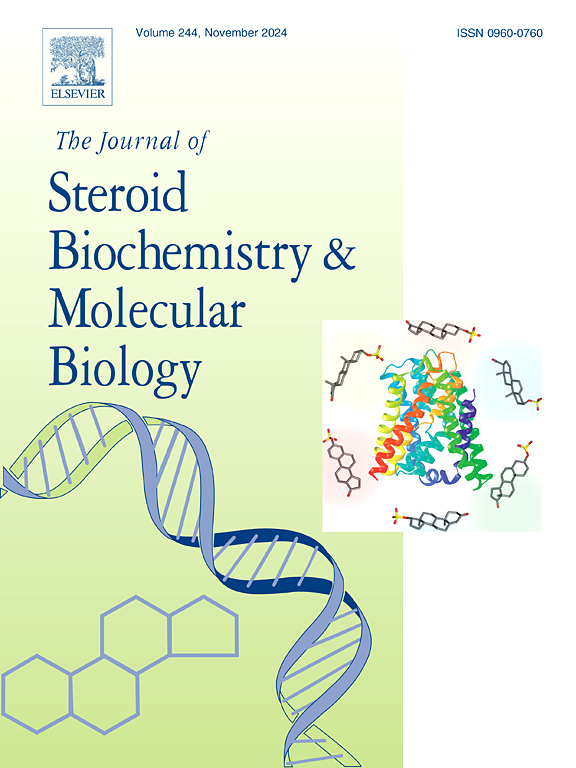二硫代氨基甲酸酯对人脑类固醇5α-还原酶1的抑制作用:一个全面的酶和结构分析。
IF 2.5
2区 生物学
Q3 BIOCHEMISTRY & MOLECULAR BIOLOGY
Journal of Steroid Biochemistry and Molecular Biology
Pub Date : 2025-05-31
DOI:10.1016/j.jsbmb.2025.106794
引用次数: 0
摘要
我们研究了二硫代氨基甲酸酯(dtc)对人类固醇5α-还原酶1 (SRD5A1)的抑制作用,SRD5A1是将睾酮或孕烯醇酮转化为神经活性类固醇的关键酶。利用酶分析、分子对接模拟、构效关系(SAR)和3D定量SAR (3D- qsar)分析等综合方法,我们评估了dtc与SRD5A1在人SF126细胞中的效力和相互作用机制。结果表明,二丁基二硫代氨基甲酸锌、二硫仑、铁仑、铁仑和锆仑对SRD5A1具有显著的抑制活性,IC50值分别为1.10、1.62、2.31、1.74和1.84μM。动力学研究表明,这些化合物具有混合抑制剂的功能,表明与酶的活性位点有多方面的相互作用。这些dtc有效穿透SF126细胞的细胞膜,抑制SRD5A1≥5μM。分子对接分析显示,这些化合物与位于SRD5A1的NADPH和睾酮结合位点之间的独特结构域相互作用,主要通过硫键相互作用,硫键是DTC结构的基本组成部分。实验证明,巯基还原剂二硫苏糖醇共孵育可以显著逆转二丁基二硫氨基甲酸锌和硫胺的抑制作用,从而验证了抑制机制。SAR分析显示LogP、分子量与IC50值呈负相关,LogP、最低结合能与IC50值呈正相关。3D-QSAR分析进一步表明,氢键受体和疏水区能力对初级抑制有重要作用。总之,本研究显著提高了我们对含硫dtc作为人SRD5A1抑制剂的SAR的认识,为确定针对该酶的dtc的毒性提供了有价值的见解。本文章由计算机程序翻译,如有差异,请以英文原文为准。
Inhibition of brain human steroid 5α-reductase 1 by dithiocarbamates: A Comprehensive enzymatic and structural analysis
We investigated the inhibitory effects of dithiocarbamates (DTCs) on human steroid 5α-reductase 1 (SRD5A1), an enzyme crucial for the conversion of testosterone or pregnenolone into neuroactive steroids. Utilizing a comprehensive approach that included enzyme assays, molecular docking simulations, and both structure-activity relationship (SAR) and 3D quantitative SAR (3D-QSAR) analyses, we assessed the potency and interaction mechanisms of DTCs with SRD5A1 in human SF126 cells. Our results demonstrated that zinc dibutyldithiocarbamate, disulfiram, ferbam, thiram, and ziram displayed significant inhibitory activity against SRD5A1, with IC50 values of 1.10, 1.62, 2.31, 1.74, and 1.84 μM, respectively. Kinetic studies indicated that these compounds function as mixed inhibitors, suggesting a multifaceted interaction with the enzyme's active site. These DTCs effectively penetrated the cell membrane of SF126 cells to inhibit SRD5A1 at ≥ 5 μM. Molecular docking analyses revealed that these compounds interacted with a distinct domain located between the NADPH and testosterone binding sites of SRD5A1, primarily through sulfur bonds, which are a fundamental component of the DTC structure. Experimental validation of the inhibitory mechanism was achieved by demonstrating that the co-incubation of dithiothreitol, a sulfhydryl-reducing agent, significantly reversed the inhibitory effects of zinc dibutyldithiocarbamate and thiram. SAR analysis revealed a negative correlation between LogP, molecular weight, and IC50 values, and a positive correlation between LogS, lowest binding energy, and IC50 values. The 3D-QSAR analysis further indicated that hydrogen bond acceptor and hydrophobic region capabilities significantly contribute to the primary inhibition. In conclusion, this research significantly advances our understanding of the SAR of sulfur-containing DTCs as inhibitors of human SRD5A1, providing valuable insights for identifying toxicity of DTCs targeting this enzyme.
求助全文
通过发布文献求助,成功后即可免费获取论文全文。
去求助
来源期刊
CiteScore
8.60
自引率
2.40%
发文量
113
审稿时长
46 days
期刊介绍:
The Journal of Steroid Biochemistry and Molecular Biology is devoted to new experimental and theoretical developments in areas related to steroids including vitamin D, lipids and their metabolomics. The Journal publishes a variety of contributions, including original articles, general and focused reviews, and rapid communications (brief articles of particular interest and clear novelty). Selected cutting-edge topics will be addressed in Special Issues managed by Guest Editors. Special Issues will contain both commissioned reviews and original research papers to provide comprehensive coverage of specific topics, and all submissions will undergo rigorous peer-review prior to publication.

 求助内容:
求助内容: 应助结果提醒方式:
应助结果提醒方式:


